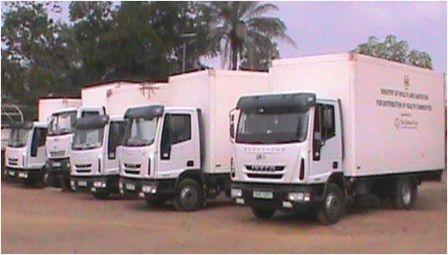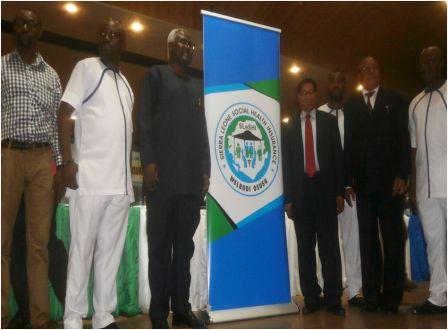First phase of the 2011 free health care drug distribution
Health for All Coalition-Sierra Leone a Civil Society Health Advocacy Network working to enhance Social Accountability in the implementation of the Free Health Care policy in Sierra Leone through monitoring, campaign, Community education, networking and partnership.
Having monitored the first phase of the 2011 Free Health Care drug distribution across the Country from May to October 2011 for the second phase of the policy implementation wishes to comment as follows:
1. Large discrepancies in the distribution of drugs across the country.
Some drugs were recorded on the dispatching waybill but not received, some were received but either short in quantity or in excess. Some drugs were supplied but not indicated in the dispatching waybill.
During the period of May to October 2011,59,160,545 units(tablets, bottles, Injection, capsules etc) of drugs were recorded to have been quantified at the central medical stores, which comprised of 45 containers of Free Health Care drugs Offloaded at the Central medical stores and Datsun Garage in Kissy.
2. Quantity of drugs supplied does not match with the quantity of drugs received.
a. 15,820,343 units of drugs were supplied to all district medical stores and Government hospitals. This represents 26.74% of the total drugs quantified at the central medical stores, but 14,230,325 units of drugs were received at the district medical stores and hospitals which represent 24.05% of drugs quantified at central medical stores.
b. Out of 15,820,343 units of drugs supplied to all districts, 11,482,395 units of drugs were supplied to district medical stores and 10,482,075 were received by district medical stores. This represents 19.41% and 17.72% of the total drugs supplied and received from the central medical stores respectively.
c. 4,337,948 units of drugs were supplied to Government referral hospitals and they received 3,748,250 units of drugs. This represents 7.33% and 6.34% of drugs supplied and received from the central medical stores.
d. In total, 1,590,018 units of drugs indicated in the dispatching waybill were not received at the districts and hospitals from the central medical store. This accounts for 2.69% of the total drugs quantified at the central medical stores. 1,000,320 units of drugs were not received at the district medical stores and represents 1.69% of the total drugs quantified at the CMS. 589,698 units of drugs were not received at Government referral hospitals and this measure 0.99% of the total drugs at CMS.
3. Both the central medical store and Datsun garage were full with drugs and medical supplies.
- Datsun garage is not air conditioned and not good for the storage of drugs and medical supplies for a long time. Drugs have been kept there for a long time which might affect the potency of the drugs.
- A drug called Amoxcyline syrup has been observed to have been procured and offloaded at the central medical store in large quantity. 8 containers have been offloaded altogether.
- The three trucks donated by UNFPA for drug distribution are still packed at the central medical stores and not used, whiles private vehicles are hired by UNICEF for distribution.
- UNICEF hired trucks for drug distribution are not road worthy and causes delay in the distribution of drugs to both the district medical stores and PHUs.
- HFAC have observed with evidence that the vehicle hired were not from company, but rather hired from private vehicle owners.
- Some of the drugs were packed in one cartoon and labeled Assorted and in the waybill there is no description like assorted drugs. This has created confusion and discrepancies in the process.
- Poor coordination and information sharing in the distribution of drugs from the districts medical stores to the PHUs. Some partners who are supposed to be in the process according to the new distribution matrix are not normally present.
- The quantity of drugs supplied to the districts will not last long. Most districts have begun to run out of drugs even before distribution to all PHUs. Drugs supplied are very small as compared to the demand of the people.
- Many districts have begun to distribute drugs and supplies to the PHUs, even though the pace is too slow.
- Inadequate labour force to offload and load drugs from the district medical stores to the PHUs.
- Some drugs supplied to the district medical stores and hospitals have expired and some will expire within a month.
- In Some districts, Stores managers are absent from their duty post when distribution to the PHUs was in progress e.g. Bombali, Moyamba, Pujehun and Kenema.
4. Reasons for Discrepancies in the drug distribution process
The following were provided by HFAC drug monitors as reasons for the discrepancies in the drug distribution process across the country;
- Some excesses and shortages of drugs supplied from the central medical store to the district. The excesses and shortages were as a result of the fact that at the central medical stores, because of the quantity of drugs involved and the workload, they count by pack size and at district medical stores they count by unit of drugs. (See attached sample of discrepancy report that shows excesses and shortages)
- Some drugs indicated in the dispatching waybill from the central medical store were not found at the districts stores and hospitals (see attached sample waybill). The reasons for these are;
- Drugs were loaded in haste which did not allow for proper checking
- Drugs at the Central medical stores were not loaded systematically.
- Some of the drugs were received at district stores and hospitals but not indicated in the dispatching waybill from the central medical stores. There is no sufficient and specific time allocated for packing and verification of drugs at the central medical stores.
We recommend as follows;
- MOHS to supply enough drugs to districts and hospitals to reduce stock outs.
- MOHS and partner to urgently use the three trucks donated by UNFPA for the purpose of which it was given, so as to speed up drug distribution to the PHUs.
- Electricity supply to the various district medical stores needed to be improved, local council intervention is needed as requested by His Excellency the President
- UNICEF to consider reviewing the contract with the hired private vehicles owners as most of these trucks are not road worthy. Organized and recognized private transport company should be hired.
- DHMTs to work out coordination modalities between drug monitoring stakeholders (HFAC,ONS,ACC,SLP, Council, stores managers and pharmacist) to improve on cooperation and information sharing.
- More labour needed to be hired by DHMTs and Local councils to offload and load drugs.
- MOHS to recruit more personnel in the various district stores across the country.
- Central medical store personnel should use the CHANNEL waybill to packed drugs before distribution.
- Central medical store personnel should organize their system for packing and distribution of drugs. Sufficient time should be allocated for packing and verification before loading.
SIGNED: ALHASSAN BAKARR KAMRA, PROGRAMME MANAGER, HEALTH FOR ALL COALITION, 076-880885
Stay with Sierra Express Media, for your trusted place in news!
© 2011, https:. All rights reserved.






